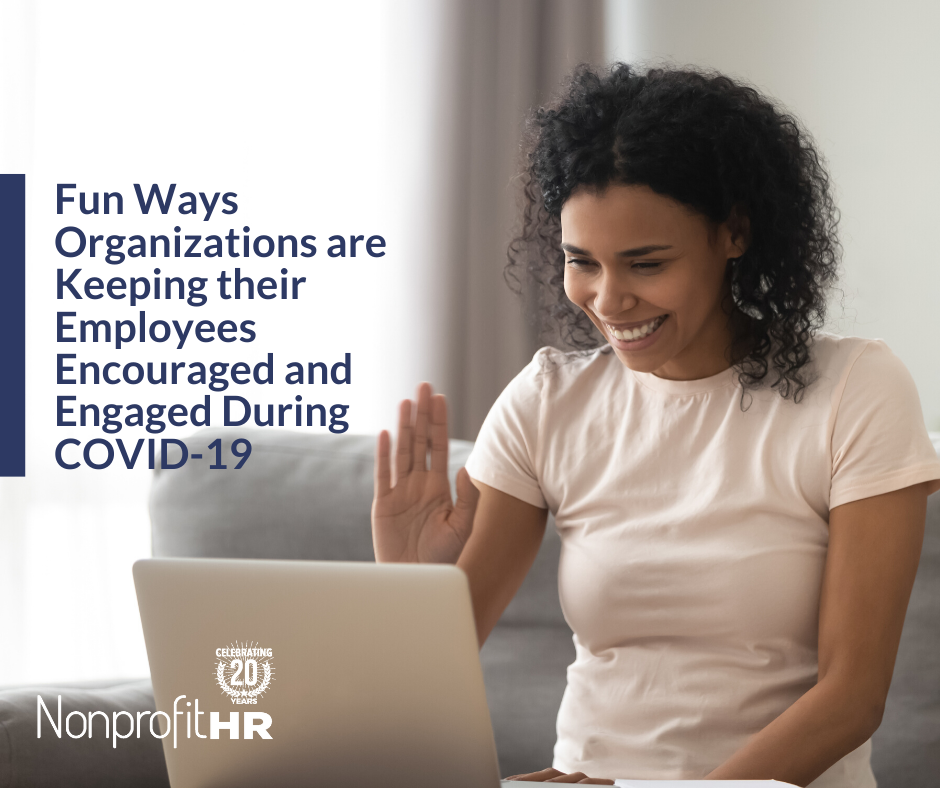WTOP: 5 ways nonprofits can…
The nonprofits we work with are full of smart people with excellent intentions and good hearts, people who truly want to serve their communities. But nonprofits are not exempt from biases when it comes to diversity and inclusion.
While 9 out of 10 nonprofit employees believe their organization values diversity, more than 7 out of 10 think their employer doesn’t do enough to create a diverse, inclusive workplace. More specifically, according to our 2016 Nonprofit Employment Practice survey, 59 percent of nonprofits don’t have a formal diversity and inclusion strategy. It can be a sensitive topic and a seemingly overwhelming task, but in today’s social and political landscape, we can’t afford to ignore it. We need new ideas and perspectives. We need to listen to and learn from each other in order to grow our organizations and further our missions.
An organization’s approach to diversity and inclusion has an impact on its overall success and growth. McKinsey’s recent “Diversity Matters” report, which examined data from 366 public companies around the world, found that companies in the top quartile for racial and ethnic diversity are 35 percent more likely to have financial returns above their respective industry medians. Those in the top quartile for gender diversity are 15 percent more likely to see that level of financial returns. For nonprofits, that means the level of diversity within an organization has the power to propel or inhibit its mission-driven work.
Biases can be very subtle, so you may not even realize that you’re hurting your organization’s approach to diversity and inclusion. Don’t be afraid to take a closer look at your workforce and see where you can make improvements. Making change begins with awareness and conversation. It starts with getting honest about what’s going on.
Here are a few areas where organizations often overlook the opportunity to embrace diversity:
1. They don’t see the people they serve as potential employees.
It’s crucial that the communities we serve have a voice within our organizations. Too often, nonprofits—especially ones associated with charter schools, social services or low-income populations—do not expand their employment searches to include those they work with. Or there will be a discrepancy between the workforce and the community, such as instances where an all-white staff will serve a community of color. Within the nonprofit sector, we frequently rely on our personal networks to recruit new talent, which means we risk building a staff of people who are just like us.
2. They judge job candidates based on where they went to school, their names or other information provided in their application materials.
As human beings, we battle unconscious bias. We may judge someone we don’t know based on specific pieces of information, rather than getting to know who they truly are. For some, that bias is then carried through into their actions. For example, the vacation rental company Airbnb created fake profiles to test owners’ bias toward individuals who inquire about staying at their properties, as Airbnb hosts can choose whom they rent to. The study revealed that potential renters with names that suggested they were African American received positive responses only 42 percent of the time, versus 50 percent for those with a white-sounding name. These types of judgments can translate to hiring practices and present a very real threat to the desire to create a diverse workforce.
3. They skew toward hiring younger people because they don’t have to pay them as much or because they feel older candidates are out of touch.
When budgets are tight, it’s all too easy to recruit younger, less experienced talent and then position it as looking for someone who can “come into the role and grow with the organization,” which devalues the skills and talents both older and younger employees have to offer. Or, when an organization wants to reinvent their culture or processes, it’s easy to latch onto the perception that only younger people can utilize new technology or produce fresh ideas. As a result, older unemployed workers face a tough time finding new jobs: Those in their 50s are 20 percent less likely than 25- to 34-year-olds to become re-employed. And people who were 44+ years old were unemployed an average of 4.5 weeks less than younger age groups pre-recession, but six weeks longer during and five weeks longer after the downturn.
4. The board doesn’t reflect the diversity of the community they serve.
Similar to the for-profit sector, the more senior the position within a nonprofit, the less diverse the people typically are. A national survey of nonprofits in the U.S. found that 86 percent of board members are white (non-Latino), while only 7 percent are African American or black and 3.5 percent are Latino. Because executive boards do not typically reflect the diversity of the community or region their nonprofits serve, leadership can have a hard time understanding the unique challenges of their community and may overlook opportunities to integrate those members’ thoughts and ideas into the organization’s work. When it comes to gender diversity, research shows that companies with diverse executive boards outperform those with male-only boards. For the 1,050 companies included the data set, that discrepancy equates to an opportunity cost of $655 billion in one year’s time.
5. They have different sets of expectations for people, depending on their race, age or other characteristics.
It might be as subtle as making reference to how an African-American woman is “well spoken” or an African-American male “looks the part,” which insinuates that they are exceptions. Or perhaps it’s shying away from applicants with names that sound foreign or questioning the abilities or credentials of certain individuals strictly because of their gender, age or sexual orientation. In one instance, an African-American man interviewed for an executive-level position at an organization that wasn’t overly formal. Because the candidate wore a suit, the committee questioned whether he would fit into the organization’s more laid back work environment (although if he had dressed casually, they likely would have said he seemed “unprepared” or “unqualified”). His appearance was subjected to that scrutiny, while those of other races were not, because of the committee members’ biased expectations. Ultimately, the candidate was hired—but only after the CEO called out the search committee on their misplaced judgments.
If you see situations like these taking place within your nonprofit, it’s time to step up and speak out. What can you do to make this right? We have some ideas to get you started:
Engage the community at multiple levels.
Talk to the people you’re serving, their families, local university groups, different communities within your city. Ask for recommendations for diverse and qualified candidates. Resist thinking you have to “lower the bar” in order to create an inclusive workplace. It’s really about opening up your search beyond your usual network to recruit in new and different places.
Eliminate unconscious bias within the hiring process.
A number of companies have implemented diversity and anti-bias training, as well as tools and technology such as bias-neutralizing software, to improve their recruiting efforts. Every step of the hiring process, from how the job description is written to who conducts the interviews, has an impact on the ultimate hiring decision. At Cisco, for example, using ethnically and gender-diverse interview panels increased the likelihood of hiring a woman by 50 percent and the hiring of Latino and black candidates by 50 and 70 percent, respectively.
Be honest about where you are in your journey.
The actual diversity of an organization’s staff is the top indicator to nonprofit employees of its commitment to diversity and inclusion. When you start reaching out to people of color or people of different sexual orientations, be open about how you’re making an intentional effort to build a diverse workforce. It might feel uncomfortable to address your organization’s weaknesses so explicitly, but that honesty can be refreshing and reassuring to candidates who might wonder if they’ll feel welcomed.
Create a welcoming environment.
In order to build a sense of inclusion, your organizational culture will have to reflect an authentic, welcoming spirit. Breaking down biases and opening up new dialogues are vital parts of creating a workplace in which your diverse staff can thrive. Research has shown that organizations that value diversity are seen as attractive to nontraditional candidates. Small actions, such as including diversity statements on a website or depicting diverse professionals in marketing materials, have been found to positively affect candidates’ perceptions of an organization.
If the topic of diversity and inclusion seems overwhelming, here’s the very first step you should take: have an honest conversation with key leaders in which you acknowledge that your workforce needs some adjustments.
As Americans, we often feel uncomfortable talking about prejudices and misperceptions. We disengage, get emotional or completely avoid the topic. Why? Because people don’t like feeling guilty, defensive, discounted—those complex feelings that arise while talking about these important issues.
No matter where you’re coming from—no matter what your race, ethnicity, age, gender, sexual orientation—it’s a tough but important conversation to have. So all too often, we simply avoid addressing diversity (or the lack of it) within the context of our workforce.
Take that first step by bringing awareness. Start the dialogue. Honor people’s experiences and commit to work together to make things different. Engage those people who are underrepresented in your workforce and gather ideas for solutions. Reach out to people you respect, people who do this work every day.
As a part of our commitment to this effort, we plan to launch a new track at our 2017 Nonprofit Talent & Culture Summit around important diversity, equity and inclusion issues impacting the nonprofit workforce. In the meantime, I urge you to ask questions, listen and get honest about what’s going on—and then take action. If you don’t, you’ll be missing out on so much untapped talent, all of those incredible people who have the ability and passion to move your mission forward in a uniquely powerful way.





























